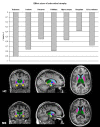Gray matter imaging in multiple sclerosis: what have we learned?
- PMID: 22152037
- PMCID: PMC3262750
- DOI: 10.1186/1471-2377-11-153
Gray matter imaging in multiple sclerosis: what have we learned?
Abstract
At the early onset of the 20th century, several studies already reported that the gray matter was implicated in the histopathology of multiple sclerosis (MS). However, as white matter pathology long received predominant attention in this disease, and histological staining techniques for detecting myelin in the gray matter were suboptimal, it was not until the beginning of the 21st century that the true extent and importance of gray matter pathology in MS was finally recognized. Gray matter damage was shown to be frequent and extensive, and more pronounced in the progressive disease phases. Several studies subsequently demonstrated that the histopathology of gray matter lesions differs from that of white matter lesions. Unfortunately, imaging of pathology in gray matter structures proved to be difficult, especially when using conventional magnetic resonance imaging (MRI) techniques. However, with the recent introduction of several more advanced MRI techniques, the detection of cortical and subcortical damage in MS has considerably improved. This has important consequences for studying the clinical correlates of gray matter damage. In this review, we provide an overview of what has been learned about imaging of gray matter damage in MS, and offer a brief perspective with regards to future developments in this field.
Figures




Similar articles
-
Gray matter damage in multiple sclerosis: Impact on clinical symptoms.Neuroscience. 2015 Sep 10;303:446-61. doi: 10.1016/j.neuroscience.2015.07.006. Epub 2015 Jul 8. Neuroscience. 2015. PMID: 26164500 Review.
-
Gray and normal-appearing white matter in multiple sclerosis: an MRI perspective.Expert Rev Neurother. 2007 Mar;7(3):271-9. doi: 10.1586/14737175.7.3.271. Expert Rev Neurother. 2007. PMID: 17341175 Review.
-
Unraveling the relationship between regional gray matter atrophy and pathology in connected white matter tracts in long-standing multiple sclerosis.Hum Brain Mapp. 2015 May;36(5):1796-807. doi: 10.1002/hbm.22738. Epub 2015 Jan 27. Hum Brain Mapp. 2015. PMID: 25627545 Free PMC article.
-
T1- and T2-based MRI measures of diffuse gray matter and white matter damage in patients with multiple sclerosis.J Neuroimaging. 2007 Apr;17 Suppl 1:16S-21S. doi: 10.1111/j.1552-6569.2007.00131.x. J Neuroimaging. 2007. PMID: 17425729 Review.
-
Increased cortical grey matter lesion detection in multiple sclerosis with 7 T MRI: a post-mortem verification study.Brain. 2016 May;139(Pt 5):1472-81. doi: 10.1093/brain/aww037. Epub 2016 Mar 8. Brain. 2016. PMID: 26956422
Cited by
-
An Observational Study to Assess Brain MRI Change and Disease Progression in Multiple Sclerosis Clinical Practice-The MS-MRIUS Study.J Neuroimaging. 2017 May;27(3):339-347. doi: 10.1111/jon.12411. Epub 2016 Dec 5. J Neuroimaging. 2017. PMID: 27918139 Free PMC article.
-
Objectively Measured Physical Activity Is Associated with Brain Volumetric Measurements in Multiple Sclerosis.Behav Neurol. 2015;2015:482536. doi: 10.1155/2015/482536. Epub 2015 Jun 4. Behav Neurol. 2015. PMID: 26146460 Free PMC article.
-
Improving Health of People With Multiple Sclerosis From a Multicenter Randomized Controlled Study in Parallel Groups: Preliminary Results on the Efficacy of a Mindfulness Intervention and Intention Implementation Associated With a Physical Activity Program.Front Psychol. 2021 Dec 24;12:767784. doi: 10.3389/fpsyg.2021.767784. eCollection 2021. Front Psychol. 2021. PMID: 35002857 Free PMC article.
-
Early silent microstructural degeneration and atrophy of the thalamocortical network in multiple sclerosis.Hum Brain Mapp. 2016 May;37(5):1866-79. doi: 10.1002/hbm.23144. Epub 2016 Feb 27. Hum Brain Mapp. 2016. PMID: 26920497 Free PMC article.
-
The clinico-radiological paradox of cognitive function and MRI burden of white matter lesions in people with multiple sclerosis: A systematic review and meta-analysis.PLoS One. 2017 May 15;12(5):e0177727. doi: 10.1371/journal.pone.0177727. eCollection 2017. PLoS One. 2017. PMID: 28505177 Free PMC article.
References
-
- Sander M. Hirnrindenbefunde bei multipler Sklerose. Monatschrift Psychiatrie Neurol. 1898;IV:427–436.
-
- Schob F. Ein Beitrag zur patologischen Anatomie der multiplen Sklerose. Monatschrift Psychiatrie Neurol. 1907;22:62–87. doi: 10.1159/000211848. - DOI
-
- Dinkler M. Zur Kasuistik der multiplen Herdsklerose des Gehirns und Ruckenmarks. Deuts Zeits f Nervenheilk. 1904;26:233–247. doi: 10.1007/BF01667829. - DOI
-
- Dawson JW. The Histology of Multiple Sclerosis. Trans R Soc Edinburgh. 1916;50:517–740.
Publication types
MeSH terms
LinkOut - more resources
Full Text Sources
Medical

